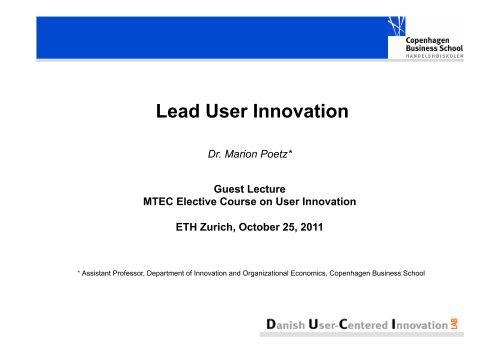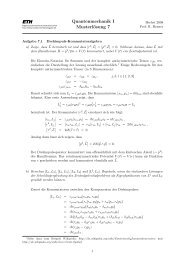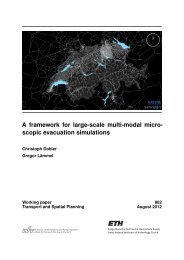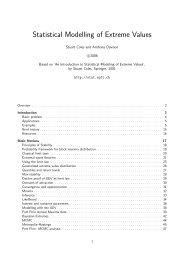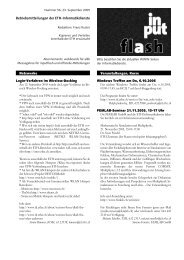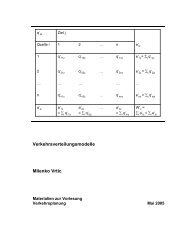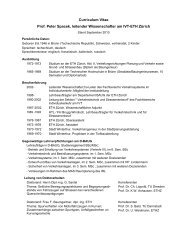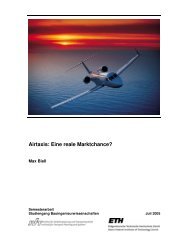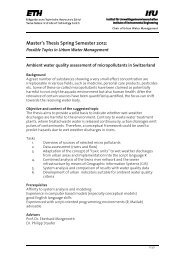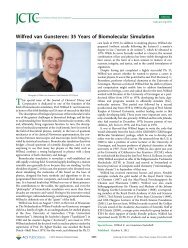Lead User Innovation
Lead User Innovation
Lead User Innovation
Create successful ePaper yourself
Turn your PDF publications into a flip-book with our unique Google optimized e-Paper software.
<strong>Lead</strong> <strong>User</strong> <strong>Innovation</strong><br />
Dr. Marion Poetz*<br />
Guest Lecture<br />
MTEC Elective Course on <strong>User</strong> <strong>Innovation</strong><br />
ETH Zurich, October 25, 2011<br />
* Assistant Professor, Department of <strong>Innovation</strong> and Organizational Economics, Copenhagen Business School<br />
© Marion Poetz 2011
About myself...<br />
Dr. Marion Poetz<br />
Assistant Professor<br />
Department of <strong>Innovation</strong> and Organizational Economics<br />
Email: mp.ino@cbs.dk, Phone: +45-3815-2914, Web: http://uk.cbs.dk/staff/marion_poetz<br />
• Research focus: Management of <strong>Innovation</strong> and Technology, Open and Distributed <strong>Innovation</strong>, Search,<br />
<strong>User</strong> <strong>Innovation</strong>, Knowledge Co-Creation, New Product Development<br />
• Visiting scholar at MIT Sloan School of Management, Bocconi University and ETH Zurich<br />
• Affiliated with the Danish Research Unit for Industrial Dynamics (DRUID, www.druid.dk), the Danish <strong>User</strong>centered<br />
<strong>Innovation</strong> Lab (www.duci.dk), the CBS World Class Research Environment in Open <strong>Innovation</strong>,<br />
the BioBusiness & <strong>Innovation</strong> Program (www.bbip.dk) and winnovation consulting (www.winnovation.at)<br />
• Further development of the lead user method, development of a training program for conducting lead user<br />
studies in firms<br />
• Development of connect & innovate TM framework for assessing and developing organizations’<br />
collaborative innovation potential<br />
• Consulting various institutions, governmental agencies and ministries<br />
• Several distributed innovation research and appliction projects in cooperation with e.g.:<br />
© Marion Poetz 2011
Agenda for today<br />
(1) 08:15-09:00 Who are lead users?<br />
• <strong>Lead</strong> user characteristics<br />
• <strong>Lead</strong> users from target vs. analogous markets<br />
• Value of lead user innovation<br />
(2) 09:00-09:15 Break<br />
(3) 09:15-10:00 Generating radical innovation using the lead user method<br />
• Setting the goals (phase 1)<br />
• Identifying important “market trends” (phase 2)<br />
• Identifying lead users (phase 3)<br />
• <strong>Lead</strong> user workshop (phase 4)<br />
à� Insights are based on a number of case studies, qualitative and quantitative data<br />
including controlled experiments and consulting experience gained over the last years<br />
© Marion Poetz 2011
(1) Who are lead users?<br />
© Marion Poetz 2011
Group discussion<br />
Characteristics of lead users<br />
• What do you think characterizes a lead user?<br />
© Marion Poetz 2011
Where do breakthroughs come from?<br />
Center-pivot<br />
systems for<br />
irrigation – a<br />
major agricultural<br />
innovation<br />
Source: von Hippel 2006<br />
© Marion Poetz 2011
Where do breakthroughs come from?<br />
The innovating<br />
company<br />
(claimed to be<br />
the source of<br />
innovation)<br />
Source: von Hippel 2006<br />
© Marion Poetz 2011
Often, users have been the actual<br />
innovators at the leading edge…<br />
…where markets are by definition small and uncertain!<br />
The original source of<br />
innovation – a (lead)<br />
user?<br />
Source: von Hippel 2006<br />
© Marion Poetz 2011
<strong>User</strong>s have often been the innovators<br />
at the leading edge…<br />
…where markets are by definition small and uncertain!<br />
John Heysham Gibbon – physician, USER -<br />
inventor of the heart-lung machine.<br />
• The death of a young patient in 1931<br />
motivated Dr. Gibbon to develop a heartlung<br />
bypass machine, to enable more<br />
effective heart surgery techniques.<br />
• Gibbon was dissuaded by all with whom he<br />
broached the subject but persevered<br />
• In 1935 he successfully used a prototype<br />
heart-lung bypass machine on animals… In<br />
1953 first used a heart-lung machine on a<br />
human patient…<br />
Why did a USER have to develop the first heartlung<br />
machine?<br />
At the start of something really new there is<br />
no “proven” market!<br />
© Marion Poetz 2011
Which users come up with the most<br />
attractive user innovations?<br />
Commercially attractive user innovation activities are concentrated among a special<br />
sub-group of users (lead users)<br />
<strong>User</strong>s needing<br />
a new product<br />
<strong>Lead</strong><br />
users<br />
find<br />
solution<br />
<strong>Lead</strong><br />
users<br />
Commercial products available<br />
Early Adopters<br />
Routine <strong>User</strong>s<br />
Source: von Hippel/Thomke/Sonnack 1999<br />
time<br />
© Marion Poetz 2011
Examples for lead user innovations<br />
Tim Berners Lee – inventor of the world wide web<br />
# of users<br />
perceiving<br />
need<br />
<strong>Lead</strong> <strong>User</strong>s<br />
innovating<br />
Manufacturers might take over innovation and produce large-scale<br />
- Tim needed hypertext and<br />
network computers for his own work (CERN)<br />
- The market as a whole followed<br />
- Major cultural phenomenon<br />
time<br />
- Emergence of companies and industries based<br />
on this radical innovation<br />
© Marion Poetz 2011
Examples for lead user innovations<br />
Gary Fisher – inventor of the mountain bike<br />
# of users<br />
perceiving<br />
need<br />
<strong>Lead</strong> <strong>User</strong>s<br />
innovating<br />
Manufacturers might take over innovation and produce large-scale<br />
time<br />
- Gary´s passion was biking off-road<br />
- He desperately needed a bike that suited his extreme<br />
requirements…<br />
- … and started to develop the first mountain bike<br />
- Driving off-road became easier and safer for him and<br />
hís friends – successful in many competitions<br />
- Gary founded his own firm: www.fisherbikes.com<br />
- Mountain biking is nowadays a mass sport with a<br />
respective industry behind it<br />
© Marion Poetz 2011
Examples for lead user innovations<br />
Nat Sims – development of computerized infusion pumps<br />
# of users<br />
perceiving<br />
need<br />
<strong>Lead</strong> <strong>User</strong>s<br />
innovating<br />
Manufacturers might take over innovation and produce large-scale<br />
Nat Sims and the development of “smart” infusion pumps:<br />
time<br />
- High need for new device at Mass General Hospital<br />
- First ideas at around 1985<br />
- Worked with many manufacturers to find<br />
commercialization pathways – with mixed results<br />
- Core IP non-exclusively and widely licensed<br />
- Continuing development and innovative activities<br />
© Marion Poetz 2011
Who are lead users?<br />
<strong>Lead</strong> users have two central characteristics (lead user theory)<br />
Characteristics of lead users Conclusion<br />
They face needs the rest of<br />
the market will face in the<br />
future (TREND POSITION)<br />
High benefit from innovation<br />
(EXPECTED BENEFIT<br />
Source: von Hippel 2005<br />
<strong>Innovation</strong>s have a<br />
high commercial value<br />
<strong>Lead</strong> <strong>User</strong>s innovate<br />
© Marion Poetz 2011
<strong>Lead</strong> user theory<br />
<strong>Lead</strong> user characteristics positively influence the commercial attractiveness of user<br />
innovations.<br />
Commercial<br />
attractiveness of<br />
innovation<br />
10<br />
5<br />
0<br />
Source: Franke/von Hippel 2003<br />
Estimated OLS<br />
curve<br />
<strong>Innovation</strong>s<br />
2 3 4 5 6 7 8 9 10 11 12 13 14<br />
“<strong>Lead</strong> <strong>User</strong>-ness”<br />
of users<br />
© Marion Poetz 2011
Testing lead user theory<br />
<strong>Lead</strong> users (1) expect high benefits from innovation and (2) are ahead of the trend<br />
<strong>Lead</strong> user characteristics<br />
Expected benefit<br />
+<br />
Ahead of trend<br />
Resources at hand:<br />
Technical expertise<br />
Community-connection<br />
Source: Franke, von Hippel & Schreier 2006<br />
H2<br />
H1<br />
H3<br />
H4a<br />
Innovative output<br />
Likelihood<br />
of innovation<br />
H4b<br />
Attractiveness<br />
of innovation<br />
© Marion Poetz 2011
Testing lead user theory: Findings<br />
high<br />
trend position<br />
(LU component 2)<br />
low<br />
W V<br />
V V W V<br />
W<br />
V<br />
V<br />
W W<br />
V V V V<br />
V<br />
V<br />
V<br />
V<br />
V V V<br />
V V V<br />
V<br />
V<br />
V<br />
V V V<br />
V<br />
V W V V V<br />
V V<br />
V<br />
V V<br />
V V<br />
V W<br />
V V<br />
V V<br />
V<br />
V V<br />
V V<br />
V W V<br />
V V V<br />
V<br />
V<br />
V<br />
W V<br />
V V V<br />
V V W<br />
V<br />
V V<br />
V<br />
V<br />
V<br />
V V<br />
V<br />
V<br />
V<br />
V<br />
V V<br />
V V V V W<br />
V<br />
V V V<br />
V<br />
V<br />
V<br />
V<br />
V V V V<br />
V<br />
V<br />
V V V V<br />
V<br />
W<br />
V W<br />
V V V V<br />
V<br />
V V<br />
V V<br />
V V V<br />
V<br />
V V<br />
V W<br />
V<br />
V<br />
V V V<br />
V<br />
V<br />
V V V V<br />
V<br />
V<br />
V V V V V V<br />
V<br />
V<br />
V V<br />
W V<br />
V<br />
V V<br />
V<br />
V V<br />
V V V<br />
V<br />
V V V V V V<br />
V V<br />
V V<br />
V<br />
V<br />
V<br />
V V<br />
V V<br />
V<br />
V V V V<br />
V V<br />
V<br />
V<br />
V<br />
V V V<br />
V V<br />
V V V V<br />
V V V<br />
V V V V<br />
V<br />
V<br />
V V<br />
V V<br />
V<br />
V<br />
V V<br />
V<br />
V V V<br />
V<br />
V V<br />
V<br />
V<br />
V<br />
V<br />
V V V<br />
V V V<br />
V<br />
V V<br />
V<br />
V V<br />
V<br />
V<br />
V<br />
V<br />
V<br />
W W<br />
W<br />
W<br />
W<br />
W<br />
W<br />
W<br />
W<br />
W<br />
W<br />
W<br />
W<br />
W<br />
W<br />
W<br />
W W W<br />
W<br />
W<br />
W<br />
W<br />
W<br />
W<br />
W<br />
W<br />
W<br />
W<br />
W<br />
W<br />
W<br />
W<br />
W<br />
W W<br />
W<br />
W<br />
W<br />
W<br />
W<br />
W<br />
W<br />
W<br />
W<br />
W<br />
W W<br />
W<br />
W<br />
W<br />
W<br />
low<br />
Source: Franke, von Hippel & Schreier 2006<br />
∅<br />
W<br />
∅<br />
W<br />
V<br />
W<br />
W<br />
W<br />
expected<br />
benefit<br />
(LU component 1)<br />
V<br />
W<br />
W<br />
W<br />
W<br />
W<br />
effect 1:<br />
more<br />
innovators<br />
high<br />
Combined:<br />
“lead user area”<br />
effect 2:<br />
more<br />
attractive<br />
innovations<br />
V<br />
innovator<br />
Non-innovator<br />
© Marion Poetz 2011
Testing lead user theory: Findings<br />
<strong>Lead</strong> users (1) expect high benefits from innovation and (2) are ahead of the trend<br />
<strong>Lead</strong> user characteristics<br />
Expected benefit<br />
+<br />
Ahead of trend<br />
Resources at hand:<br />
Technical expertise<br />
Community-connection<br />
Source: Franke, von Hippel & Schreier 2006<br />
H2<br />
H1<br />
H3<br />
√<br />
√<br />
√<br />
H4a<br />
Innovative output<br />
Likelihood<br />
of innovation<br />
Attractiveness<br />
of innovation<br />
√ H4b √<br />
© Marion Poetz 2011
How to recognize a lead user in a “real”<br />
search process?<br />
Evaluating “lead userness” in a real setting<br />
Compare the state of the art in a<br />
certain field related to a trend with<br />
the achievements/activities/needs<br />
of the person related to that trend<br />
Proxy: Number and quality of<br />
referrals to the target person<br />
Trend Position<br />
Low high<br />
Level of a person’s benefit from an innovative<br />
solution by selling it<br />
Use<br />
Seller – Role (<strong>User</strong> Manufacturer)<br />
Experience<br />
Source: Hienerth, Pötz<br />
and von Hippel (2007)<br />
<strong>Lead</strong> <strong>User</strong>s<br />
low Expected Benefit high<br />
Level of a person’s benefit from an<br />
innovative solution by using it<br />
<strong>User</strong> - Role<br />
Change of functional role or parallel functional roles<br />
© Marion Poetz 2010<br />
2011
Search for lead users in target or<br />
analogous markets?<br />
An analogous market is a market that shares an important need with the target market.<br />
Ideally, in an advanced form.<br />
• For example: manufacturer is<br />
looking for a method of infection<br />
prevention in medical surgery<br />
(target market)<br />
• Need: avoiding air pollution<br />
(germs etc.)<br />
Source: Herstatt/Lüthje/Lettl 2002<br />
• Analogous market = chip<br />
production<br />
• Same need<br />
• Maybe better insights?<br />
© Marion Poetz 2011
Analogous market effects<br />
An analogous market/industry shares a certain problem with the target market/Industry.<br />
Ideally, in an advanced form – similarities based on attributes of the problem.<br />
• For example: manufacturer is looking<br />
for a method of infection prevention<br />
in medical surgery (target market)<br />
• Need: avoiding air pollution<br />
(germs etc.)<br />
• Analogous market = chip production<br />
• Same need<br />
• Maybe better insights?<br />
Analogous Market Effects / Distance Effects<br />
Ideas from analogous/distant markets are more novel than those from the target market<br />
(e.g. Franke and Poetz 2011, Hienerth, Pötz, von Hippel 2007, Lilien et al 2002, Jeppesen und Lakhani 2010)<br />
Less / no functional fixedness Transfer of existing solutions<br />
© Marion Poetz 2011
Empirical evidence for „analogous<br />
market effects“ in lead user studies<br />
First exploratory insights show that lead users from analogous markets are the drivers of<br />
truly novel new product concepts.<br />
Study 1 Study 2<br />
Study 3 Study 4<br />
Study 5 Study 6<br />
Study 7 Study 8<br />
Study 9 Study 10<br />
81<br />
lead<br />
users<br />
high<br />
Novelty of Concepts<br />
low<br />
3,62<br />
Target Market<br />
p
Group discussion<br />
Exercise: Identifying appropriate analogous markets<br />
• Image you have the task of developing a new running shoe, and know that<br />
one of the most important needs is to provide running shoes that are much<br />
lighter than existing ones but very stable at the same time:<br />
• In which other (analogous) markets could the need for „something“ being light<br />
and stable at the same time also be relevant, and it thus might make sense to<br />
search for lead users in these markets?<br />
• Discuss with your neighbor (2 min brainstorming) as a preparation for group<br />
discussion<br />
Source: Poetz (2008)<br />
© Marion Poetz 2011
Conclusion: Which lead users should<br />
be integrated into a lead user project?<br />
The mix of lead users makes high quality output in lead user projects<br />
Target Market<br />
(TM)<br />
Analogous<br />
Market (AM)<br />
Practical implications?<br />
<strong>User</strong>s & <strong>User</strong><br />
Manufacturers<br />
<strong>User</strong>s & <strong>User</strong><br />
Manufacturers<br />
• Know the target market (problem) (+)<br />
• Have need and solution based information (+)<br />
• Are functionally fixed by existing TM solutions (-)<br />
à� lower novelty of innovations<br />
• Don´t know the target market (problem) (-)<br />
• Have need based information in their market<br />
and can transfer existing solutions (solution<br />
based information) (+)<br />
• Are not functionally fixed by existing TM<br />
solutions (+)<br />
à� higher novelty of innovations<br />
à� To capture different aspects of information and get most innovative output:<br />
à� MIX different lead users!<br />
Source: Poetz (2008)<br />
© Marion Poetz 2010 2011
Value of lead user innovation (I)<br />
A study conducted at 3M shows clear advantages of ideas generated with the lead user<br />
method over those generated via traditional innovation methods used in companies.<br />
Novelty relative to<br />
competition 1<br />
Originality / newness of<br />
customer needs addressed 1<br />
Strategic Importance 1<br />
Idea types<br />
Estimated Sales in year 5<br />
(deflated)<br />
1 Scale: 1 = very low, 10 = very high<br />
Source: Lilien et al. (2002)<br />
<strong>Lead</strong> user ideas<br />
(n = 5)<br />
9,6<br />
8,3<br />
9,6<br />
0 incremental<br />
5 major product lines<br />
146 Mio. $<br />
Non - <strong>Lead</strong> user ideas<br />
(n = 42)<br />
6,8<br />
5,3<br />
7,3<br />
41 incremental<br />
1 major product line<br />
18 18 Mio. $<br />
p<br />
0,01<br />
0,09<br />
0,08<br />
0,01<br />
0,00<br />
© Marion Poetz 2011
Value of lead user innovation (II)<br />
The pathway from lead user innovation to industry:<br />
<strong>Lead</strong> users (<strong>Lead</strong>) users in Free sharing or<br />
starting to communities (lead) user<br />
innovate can innovate manufacturing<br />
here more cheaply<br />
Manufacturers can produce<br />
here<br />
more cheaply here<br />
# of users<br />
perceiving<br />
need<br />
(<strong>Lead</strong>) users and user communities<br />
bridge periods of technical and market<br />
risk in which manufacturers would not<br />
start investing!<br />
Source: Baldwin, Hienerth & von Hippel 2007<br />
time<br />
© Marion Poetz 2011
(2) Break<br />
© Marion Poetz 2011
(3) The lead user method<br />
© Marion Poetz 2011
<strong>Lead</strong> user method<br />
The lead user method (von Hippel 1986) is a tool to identify and integrate lead users<br />
into concrete innovation projects of a company. Basically there are four main steps:<br />
Phase 1:<br />
Definition Start des <strong>Lead</strong> of the<br />
<strong>User</strong> search Projekts field<br />
Phase 2:<br />
Identification of<br />
important unmet<br />
market needs<br />
Phase 3:<br />
Search for lead<br />
users in target<br />
and analogous<br />
markets<br />
Phase 4:<br />
Development of<br />
innovative<br />
concepts (lead<br />
user workshop)<br />
The lead user method works in many different industries, here is a selection of<br />
lead user method applications I personally have been involved:<br />
© Marion Poetz 2011
Phase 1 – Setting the goals: Developing<br />
appropriate search fields<br />
© Marion Poetz 2011
<strong>Lead</strong> user method / phase 1<br />
The lead user method has four steps:<br />
Phase 1:<br />
Definition of the<br />
search field<br />
• Specification of the search field (target market) – problem definition<br />
• Formation of interdisciplinary team<br />
• Definition of project goals (deadlines, budget, specification and requirements for<br />
innovative concepts)<br />
© Marion Poetz 2011
Tips from my experience<br />
Tips for stage 1: Search field and team<br />
à� Clear definition of search field positively influences the later search<br />
processes by increasing search efficiency (defining specifications and<br />
requirements)<br />
à� Search field should be based on real problems (technically and/or<br />
market oriented) of a company<br />
à� Clear commitment of the company is essential<br />
à� Include company internal members from different departments into the<br />
project team (marketing, R&D, production, etc)<br />
à� Consider including external search team members for a pilot study<br />
à� Collect existing company internal information with respect to the<br />
search field (e.g. existing studies, striking customers, suppliers or<br />
partners, etc.)<br />
à� Checking access to potential sources of information – are there any<br />
barriers? (e.g. are there any social desirability or secrecy reasons?)<br />
à� Goals of the company should match with possible outcome of a lead<br />
user study (solutions on a concept level, radical innovations, etc.)<br />
Source: Poetz (2008)<br />
© Marion Poetz 2011
Phase 2 – Preparing the tracks for lead user<br />
identification (identifying unmet market<br />
needs)<br />
© Marion Poetz 2011
<strong>Lead</strong> user method / phase 2<br />
The lead user method has four steps:<br />
Phase 1:<br />
Definition of the<br />
Start search des field <strong>Lead</strong><br />
<strong>User</strong> Projekts<br />
Phase 2:<br />
• Scanning of literature, internet, data bases<br />
• Interviews with market and technology experts and users<br />
• Evaluation of market trends<br />
Identification of<br />
important market<br />
trends<br />
• Selection of market trends that are most important for the search field<br />
• Market trends refer to “aggregated, not yet<br />
covered needs for ...“ in the target market*<br />
• They are the result of a qualitative data<br />
collection and pattern recognition approach<br />
Source: Poetz (2008)<br />
<strong>Lead</strong><br />
<strong>User</strong><br />
Early Adopters<br />
Routine <strong>User</strong>s<br />
*In a lead user study trends refer to<br />
aggregated, unmet user needs within<br />
the search field that are not yet<br />
addressed by existing products or<br />
services and, furthermore, usually not<br />
yet (fully) known to companies/<br />
industries.<br />
© Marion Poetz 2011
<strong>Lead</strong> user method / phase 2<br />
For classifying the results of phase 2 (“unmet need clusters”) and facilitate the decision<br />
making for later project stages we use a trend matrix:<br />
Fit with the search field<br />
high<br />
low<br />
Source: Poetz (2008)<br />
low<br />
2<br />
1<br />
Importance for the target market<br />
5<br />
4<br />
3<br />
high<br />
The size of the circles represents the number of referrals<br />
Trend Matrix<br />
© Marion Poetz 2011
Summary: Tips from my experience<br />
Tips for stage 2: Trend identification<br />
à� The most important trends are market trends (aggregated user needs),<br />
technology trends or general social/legal/economic trends might<br />
sometimes also play a role<br />
à� Look also for trends in analogous markets that might spill over<br />
à� <strong>User</strong>s are market experts – talking to users will help to get an idea of<br />
important (not yet covered) needs (market trends)<br />
à� Usually more than 10 trends are identified as being relevant, do not<br />
follow more than 3 trends for lead user identification (the selection of<br />
trends shall reduce the solution space<br />
à� Selection of most important trends can be done by looking at their<br />
relevance for the target market, their fit with the search field and the<br />
number of sources that back the trend<br />
à� Evaluation tools can support decision processes<br />
à� Use interview partners as evaluators (similar to Delphi methods)<br />
Source: Poetz (2008)<br />
© Marion Poetz 2011
Phase 3 – Identifying lead users from target<br />
and analogous markets<br />
© Marion Poetz 2011
How to find lead users?<br />
To find lead users, different search processes can be employed<br />
Pyramiding: Using references of interviewees to identify the target person at the<br />
‘top of the pyramid’ (lead user), getting stepwise to the target person<br />
Starting point: Who<br />
experiences most advanced<br />
needs related to trend X...?<br />
Source: Poetz (2008)<br />
Sources: Franke/Prügl/von Hippel (2009), Poetz (2008)<br />
Result: <strong>Lead</strong> <strong>User</strong>s<br />
Analogy: playing golf<br />
Interview guides and<br />
interviewer training<br />
© Marion Poetz 2011
Pyramiding search<br />
A performance analysis of Pyramiding search processes shows that 52,3% of all<br />
interviewees were able to make a referral. Within this sample, 35,2% were able to cross<br />
domain-specific boundaries and refer into analogous domains.<br />
Interview<br />
without<br />
referral<br />
47,7%<br />
n=1147<br />
Source: Poetz and Prügl 2010<br />
Interview<br />
with<br />
referral<br />
52,3%<br />
Withindomain<br />
referral<br />
64,8%<br />
n=600<br />
Crossdomain<br />
referral<br />
35,2%<br />
‘true’ crossing-boundaries<br />
achievement:<br />
• from target market into<br />
analogous market<br />
• from analogous market<br />
into other analogous<br />
market<br />
• Total: 326 referrals<br />
No crossing-boundaries<br />
achievement:<br />
• from target market into<br />
target market<br />
• from analogous market<br />
into same analogous<br />
market<br />
• From analogous<br />
market into target<br />
market<br />
• Total: 771 referrals<br />
© Marion Poetz 2011
How to find lead users?<br />
The underlying concept: attracting solutions from crowds (e.g. Jeppesen and Lakhani 2010)<br />
Broadcasting: Broadcast questions/problems to a crowd of potential problem solvers<br />
(e.g. opening a thread in an online communities) to identify promising<br />
ideas (and the people behind them – self selection)<br />
Asking a question (posting/thread)<br />
related to search field and/or trend<br />
Interview(s)<br />
ideas, hints and contacts<br />
Search process starting points<br />
Result: <strong>Lead</strong> <strong>User</strong>s<br />
Analogy: sowing and harvesting<br />
Source: Poetz (2008)<br />
© Marion Poetz 2011
How to find lead users?<br />
To find lead users, different search processes can be employed<br />
Content Analysis: Passively searching content in online forums for possible<br />
solutions, then contact the persons behind them<br />
Interview(s)<br />
problem issues, ideas<br />
Search process starting points<br />
Result: <strong>Lead</strong> <strong>User</strong>s<br />
Analogy: harvesting<br />
Source: Poetz (2008)<br />
© Marion Poetz 2011
Pyramiding search vs.<br />
Broadcast search<br />
Both methods target on identification of rare expertise, but have a different sequence<br />
in steps towards this goal.<br />
Pyramiding<br />
Broadcasting<br />
1 2<br />
Person<br />
Idea<br />
Idea Person<br />
© Marion Poetz 2011
Pyramiding search vs.<br />
Broadcast search<br />
Both methods target on identification of rare expertise, but have a different sequence<br />
in steps towards this goal. This leads to different strengths and weaknesses of these<br />
two search methods.<br />
Pyramiding Search<br />
Broadcast Search<br />
Person<br />
<strong>Innovation</strong>-related knowledge<br />
• Strength 1: Possiblity to adapt and refine search question during search (‚learning effect‘ on<br />
the fly)<br />
• Strength 2: Ability to cross domain-specific boundaries (reduced local search bias)<br />
• Strenght 3: Potential to interact with interviewees and get detailed insights<br />
• Weaknesses: Time and resources needed (e.g. highly skilled interviewers), ‚local optima‘<br />
because of opportunistic behavior<br />
<strong>Innovation</strong>-related knowledge<br />
Person<br />
• Strength 1: Easily accessible and observable if a few rules are respected (‚community<br />
culture‘)<br />
• Strength 2: Fully documentated search process (no ‚extra effort‘ needed)<br />
• Stength 3: Attracting solutions from diverse solvers (reduced local search bias)<br />
• Weaknesses: Dependence on problem description, lower ‚communication<br />
bandwidth‘ (e.g. mainly written communication) and ‚reach‘<br />
© Marion Poetz 2011
General tips for the search processes<br />
Please consider:<br />
ð� Early adopter ≠ <strong>Lead</strong> user…<br />
…but might be interesting for you when they come from analogous markets<br />
ð� Opinion leader ≠ <strong>Lead</strong> user…<br />
…but can be a valuable node for the pyramiding search processes<br />
ð� Technology experts ≠ <strong>Lead</strong> user…<br />
…but can (exceptionally) be considered for the workshop, e.g. certain relevant<br />
technology-related knowledge is not available from company participants<br />
Don`forget: <strong>Lead</strong> <strong>User</strong>s = <strong>Lead</strong> <strong>User</strong> Persons and <strong>Lead</strong> <strong>User</strong> Companies<br />
Source: Poetz (2008)<br />
© Marion Poetz 2011
How can you evaluate potential lead user<br />
candidates?<br />
For classifying the results of the lead user search process we use a lead user matrix…<br />
<strong>Lead</strong> <strong>User</strong> Matrix:<br />
à� Trend position and expected benefit: position in the matrix<br />
à� Main source of benefit (using, selling): design of circles<br />
à� Market origin (target or analogous market): color of circles<br />
à� Novelty of idea: size of circles<br />
Trend Position<br />
Low high<br />
Low high<br />
Expected Benefit<br />
Source: Hienerth, Poetz and von Hippel (2007)<br />
Target<br />
Analogous<br />
<strong>User</strong><br />
Seller with use<br />
experience<br />
© Marion Poetz 2011
How can you evaluate potential lead user<br />
candidates?<br />
…and other characteristics that lead to most innovative results in lead user workhops<br />
<strong>Lead</strong> <strong>User</strong> Matrix:<br />
à� Trend position and expected benefit: position in the matrix<br />
à� Current main source of benefit (using, selling): design of circles<br />
à� Market origin (target or analogous market): color of circles<br />
à� Novelty of idea: size of circles<br />
Further aspects of the person:<br />
à� Degree of use experience (in his/her market)<br />
à� Technical knowledge (in his/her market)<br />
à� Actual innovative activities (related to the target market problem)<br />
à� Aptitude to participate in the workshop (ability to communicate with others, etc)<br />
Further aspects of the market the person comes from:<br />
à� Market distance (to the target market): in terms of market related aspects<br />
à� Technical distance (to the target market): in terms of technical related aspects (how much<br />
has to be modified to solve the target market problem?)<br />
à� Progressiveness distance (peer or advanced analogous market)<br />
Further aspects of the idea:<br />
à� Status of the idea (idea, concept, prototype or commercial product)<br />
Source: Hienerth/Poetz/von Hippel (2007)<br />
© Marion Poetz 2011
Tips from my experience<br />
Tips for stage 3: <strong>Lead</strong> user identification<br />
à� The choice of the right starting points shortens the pyramiding chain<br />
and allows to identify appropriate online forums for broadcast search<br />
à� Right starting points can be identified by operationalizing trends:<br />
finding variables that help identifying people for whom the trend is<br />
critical (e.g. because of frequency, security, legal regulations, etc.)<br />
à� Use standardized interview forms for the pyramiding process and train<br />
interviewers prior to interviewing activities<br />
à� Do not mix up lead user characteristics and motives to participate in a<br />
lead user workshop<br />
à� Clarify IP rights during the interviews (prior to the lead user workshop)<br />
à� Use interview partners as evaluators for trend position (similar to<br />
Delphi methods)<br />
à� Regularly discuss results within your search team<br />
à� Ask interview partners directly for analogous markets<br />
à� Check for additional characteristics of lead users that might be relevant<br />
for the workshop<br />
Source: Poetz (2008)<br />
© Marion Poetz 2011
Phase 4 – Collaborating with lead users in a<br />
lead user workshop<br />
© Marion Poetz 2011
<strong>Lead</strong> user method / phase 4<br />
The lead user method has four steps:<br />
Phase 1:<br />
Definition of the<br />
Start search des field <strong>Lead</strong><br />
<strong>User</strong> Projekts<br />
Phase 2:<br />
Identification of<br />
important needs<br />
and trends<br />
• Conducting the workshop with lead users and company members<br />
• Development of innovative concepts<br />
• Evaluation of innovative concepts<br />
Phase 3:<br />
Identification of<br />
lead users and<br />
lead user ideas<br />
Phase 4:<br />
Development of<br />
innovative<br />
concepts (lead<br />
user workshop)<br />
© Marion Poetz 2011
Group discussion<br />
Motives for participating and sharing ideas in a lead user workshop<br />
• What do you think motivates lead users to “freely” share their ideas in a lead<br />
user workshop?<br />
© Marion Poetz 2011
What motivates lead users to freely share<br />
their ideas in lead user workshops?<br />
Intrinsic motivation seems to be the main driver for free revealing in lead user workshops<br />
Motives for free revealing<br />
40%<br />
25%<br />
35%<br />
n=9 interviews with lead user workshop participants<br />
Source: Poetz and Rütgen 2008<br />
Social motives<br />
1. Exchange ideas and thoughts with likeminded<br />
people<br />
2. Social contacts<br />
3. Pursue collaborative goals<br />
4. Gain recognition<br />
5. Societal norms and values<br />
Intrinsic motives<br />
1. Learning effects<br />
2. Pride in one‘s own contribution<br />
3. Creativity<br />
4. Emotions during innovation-related tasks<br />
5. Exploration<br />
6. Fun<br />
7. Spinning ideas/fiddling about<br />
8. Interest in the topic<br />
9. Privilege to participate<br />
Extrinsic motives (only non-monetary!)<br />
1. Low pressure of competition<br />
2. Name and reputation of the company<br />
3. Workshop ideas as stimulation for own projects<br />
4. Getting to know the lead user method<br />
5. Access to exclusive information<br />
6. Reciprocity<br />
7. Post-workshop cooperations<br />
8. Qualitatively higher standards<br />
9. Use benefit in own (target & analogous) market<br />
10. Gaining reputation<br />
11. Aiming for career perspectives<br />
12. Diffusion<br />
© Marion Poetz 2011
<strong>Lead</strong> user method / phase 4<br />
In a three days workshop lead users, together with company employees, develop<br />
innovative solutions. We use the following design:<br />
Thursday Friday Saturday<br />
Working session 1<br />
Plenum Session 1<br />
Working session 2<br />
Plenum Session 2<br />
Project Introduction<br />
Group formation<br />
Get together Evening program<br />
Source: Poetz (2008)<br />
Working session 3<br />
Plenum Session 3 and<br />
Evaluation<br />
Working Sessions: 3<br />
Teams consisting of:<br />
LU LU<br />
DOC<br />
COMP<br />
MOD<br />
LU<br />
© Marion Poetz 2011
Tips from my experience<br />
Tips for stage 4: <strong>Lead</strong> user workshop<br />
à� Create an attractive environment for the lead user workshop (hotel,<br />
travel arrangements, recreation activities, etc.)<br />
à� Create a balance between structure and creativity (moderation and<br />
documentation, goal orientation, structured process, agenda, etc.)<br />
à� Enable interactions (e.g. for feedback) between sub-groups<br />
à� Create sub-groups with diverse characteristics (optimal group mix),<br />
but…<br />
à� …check for the fit between members of a sub-group (they should be<br />
able to talk to each other)<br />
à� Support group building processes (in order to minimize “storming and<br />
forming”)<br />
à� Include company members who are familiar with the problem and the<br />
prior project results, company members play the role of checking for<br />
realizability of the solutions, but avoid “cutting” interesting ideas<br />
because of functional fixedness<br />
Source: Poetz (2008)<br />
© Marion Poetz 2011
Summary: Power of the lead user<br />
method<br />
There are three main aspects that form the power of the lead user method<br />
ð� Problem solvers with use experience<br />
• USER PERSPECTIVE<br />
• NEED BASED INFORMATION<br />
ð� <strong>User</strong>s at the leading edge of important market trends (vs. average users)<br />
• TREND POSITION<br />
• ADVANCED SOLUTION BASED INFORMATION<br />
ð� Problem solvers from analogous markets<br />
• UNBLOCKING FUNCTIONAL FIXEDNESS<br />
• TRANSFER OF EXISTING SOLUTIONS<br />
Source: Poetz (2008)<br />
© Marion Poetz 2011


